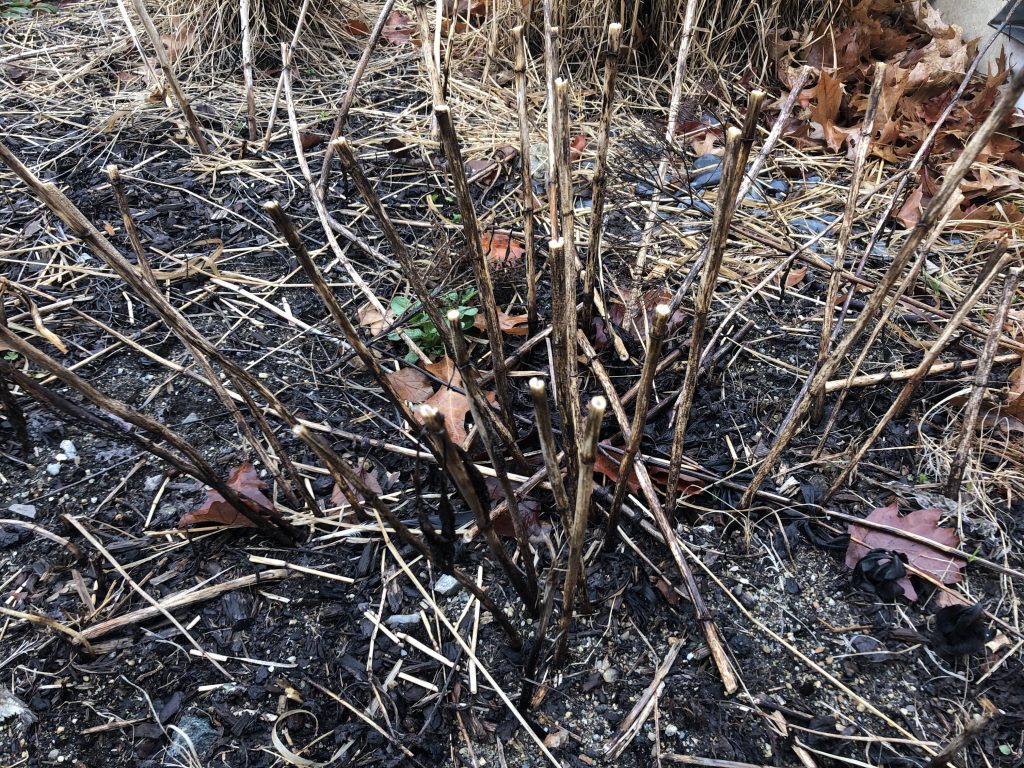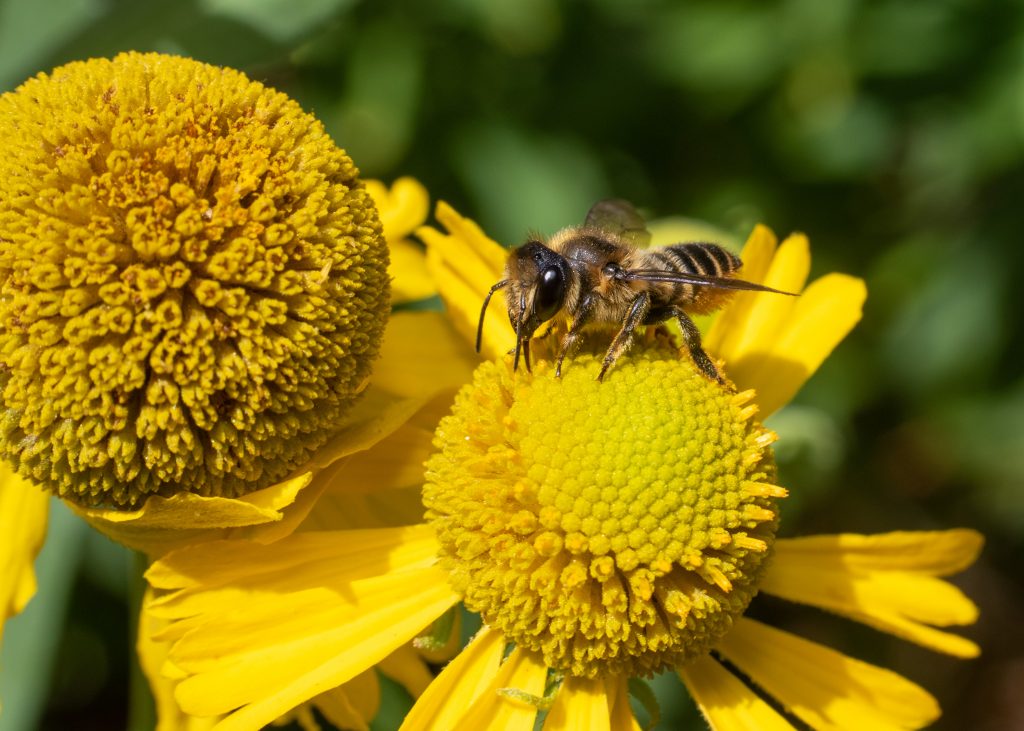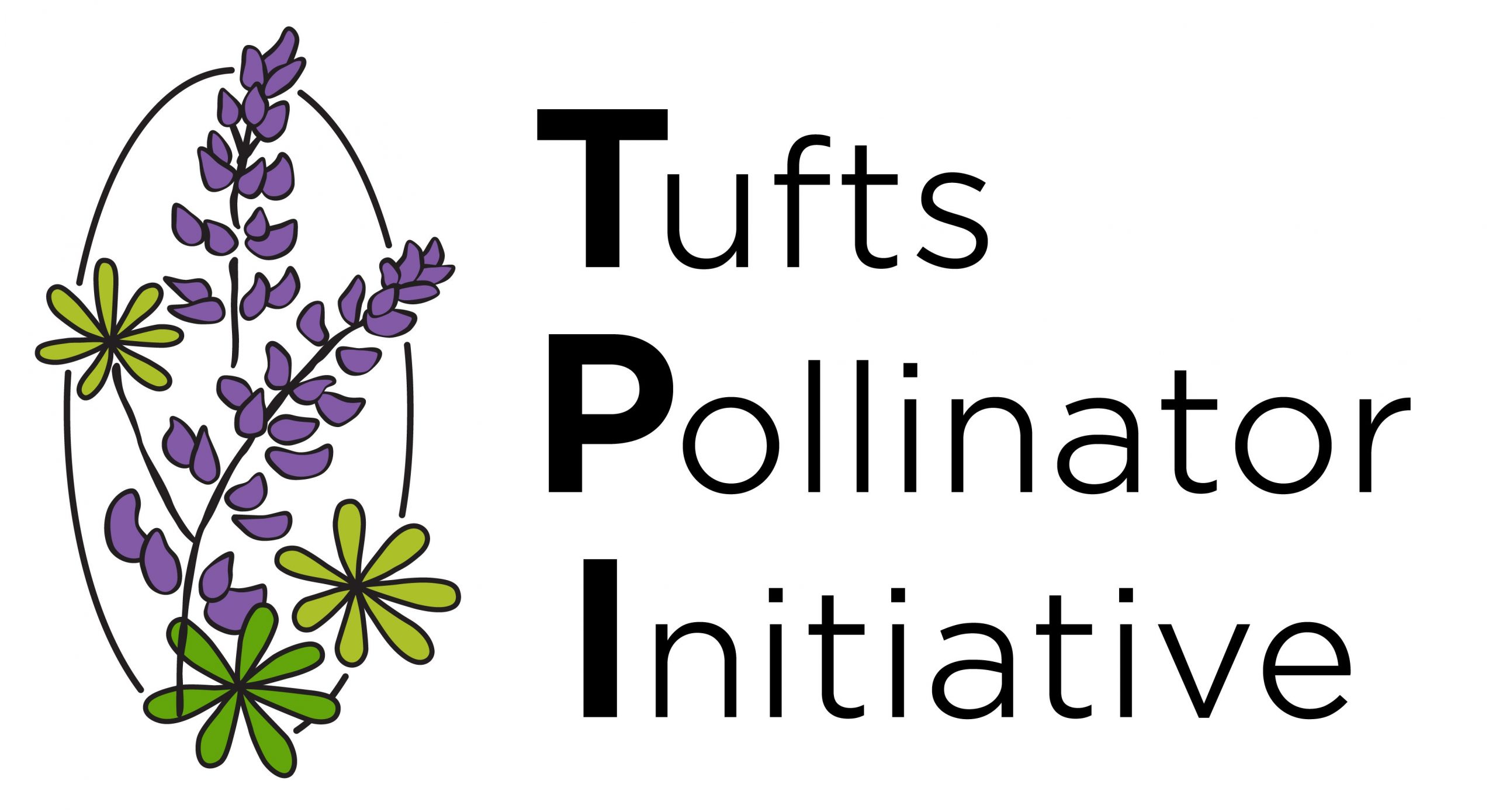About 30% of New England’s native bees build nests above ground. Besides bee hotels (many of which have their own issues), a great way to support these above-ground nesting bees is to leave dead plant stems standing in gardens. Bees will lay and provision offspring in these hollow or pithy stems. TPI members are often asked by gardeners, “when is the best time to cut down stems?” The answer is at least two years (ideally never), which is longer than you might think. Let’s review bee and plant biology to understand why.
Year 1: Plant stems are growing. Native plants like joe-pye weed, elderberry, wild bergamot, mountain mint, and swamp milkweed produce hollow or pithy (e.g. soft, spongy tissue) stems suitable for nesting bees. Bees won’t nest in these actively growing stems. At the end of the growing season (December through March), cut the stems back to between 6-18” tall. Use sharp tools to ensure a clean cut. By cutting back the stems, you have created homes for next year’s bees.

Year 2: Bees active during this year will nest in the stems you left standing. They will lay eggs in the stem and provision each egg with a nutritious ball of pollen and nectar. Inside the stem, bees will develop from eggs into larvae and adults that hibernate through winter. Bees won’t emerge from stems until next growing season. Remember to cut back the new, green stems produced this year for next year’s bees.

Year 3: In spring of year 3, stems produced in year 1 still contain bees; stems produced in year 2 do not contain bees. Leave both generations of stems standing throughout the year. Spring-active bees will emerge from year 1 stems by June, whereas fall-active species might not emerge from year 1 stems until August or early September. During this time, new bees will nest in year 2 stems, so leave them standing!
While this may seem like an awfully long time to leave stubble in a garden, it is the only way to ensure that native bees find safe, undisturbed places to nest. Posting signage in your garden to inform visitors about how gardens can be managed to balance aesthetic and ecological goals can be helpful.


this is terrific! i do education for Mo Prairie Foundation program GrowNative! and for DeepRootsKC organization. may i use this as a pdf handout? maybe see if GN can add a link to this? credit would of course be given to you as author!
Is there any way to be bee friendly but reduce with the exception of carpenter bees?
Hello Joe! Our native carpenter bees are important pollinators, and only one species is a nuisance–eastern Carpenter bees (Xylocopa virginica). They do not nest in woody stems in the garden. The carpenter bees that nest in your garden are small carpenter bees (Ceratina) and they are *much* smaller and easily overlooked.
The bigger, more conspicuous eastern carpenter bees will excavate nests in decks, eaves, siding. They are also important pollinators and players in our local ecosystems, and they are super gentle. To deter them from nesting in future years, however, you can cover up the hole with steel wool or caulk the entrance and paint over it. Absolutely please refrain from spraying chemicals.
Is there something/place we can provide as an alternate for the Eastern Carpenters? I.e., if there wasn’t a deck, where would they prefer to nest?
In the wild, carpenter bees (Xylocopa) nest in dead trees/snags in fields and along wooded edges. The issue is that many untreated decks are perceived in the same way as dead trees to carpenter bees. You can discourage carpenter bees from nesting in your deck by plugging their entrance with steel wool/caulk or painting over the deck to make it less desirable to chew through.
We had a lot of carpenter bees this year when my husband stuffed a big brown bag with paper and hung it from a string on our porch (making it look like a hornets nest). Carpenter bees left!!
Glad to hear that you solved your wasp problem in an environmentally friendly way!
Link to U Minn Extension doesn’t work. Thanks for this. A graphic would be great
Noted! I think we can make that happen.
Will the bees live in zinnia stems?
I am not sure about zinnias specifically, but here’s how you can find out: after frost, cut zinnia stems according to the instructions in the blog post. If they are hollow, there’s a good chance bees will use them.
Bees like small carpenter bees will also use pithy stems (that they can hollow out to make a just-right-sized tunnel).
Yes, that’s correct! They particularly like the pithy stems of staghorn sumac for nesting.
Thank you! A question: Will it work to cut the stems down to the ground in the winter but prop the cut stems up somewhere as if they’re still on the plant?
Hi Melissa, Great question. If you would like to cut down the stems, you can bundle the stems together and place them in a sheltered spot. Effectively, this creates a bee hotel out of your homegrown plant stems. Once of the issues with bee hotels, however, is that a high density of nesting holes results in harmful parasites and pathogens building up in nests. For this reason, I recommend leaving the stems on the plant, where bees can nest at much lower densities and used nesting cavities naturally break down after a couple of years. Think: crowded apartment building vs. spacious countryside home.
would this be relevamt for all native bees, in any area/country..?
Hi Sharon, Yes, this information applies to stem-nesting bees globally. About 30% of solitary bees nest above ground, and those are the bees that you are supporting by leaving stems standing. Leaf-cutter bees (Megachile), small carpenter bees (Ceratina), resin bees (Heriades), and masked bees (Hylaeus) are just some of the bees that will nest in stems in your garden.
I too, would like to use this as a resource for my native habitat clients. Do you have a pdf version?
Hi Trecia, thanks for the idea. We don’t currently have a pdf, but we might be able to make one.
How do you know which are year 1 stems and which are year 2. Also, how high should they be?
Hi Cathy, In general, you can distinguish year 1 and year 2 stems by how worn they are. Year one stems will have gone through an extra winter and therefore be a lot more tattered. You should cut the stems back to between 6-18” tall. Hope this helps!
to help identify the 1 year and 2 year stems Maybe you can cut the Year 1 – 6 inches high and year 2 – 12in high. Hope this helps
That’s a good way of differentiating between different generations of stems–i.e. those produced in 2021 vs. 2022. You will want to leave each generation of stems standing for at least 2 years, and *not* cut them to different heights after the initial cutting.
Does this have any application to sunflower stalks? Can they be cut back in December in a similar manner?
Yes, you can cut back sunflower stalks just like the other plants.
Can stems be used if I don’t do anything to them at all, just leave standing?
Simply leaving your stems is fine, but bees require an opening in the stem in order to nest in it. Some of the stems in your garden might have been broken by ice and snow over the winter, but many of them might still lack an opening. By making clean cuts on your stems, you will definitely create many more nesting cavities for native bees.
I think this is such valuable information! Thanks so much for posting this & including the link to these great question & answers!!! : ) I am sharing & posting excepts from the Q & A to save lives!! : )
So glad you like our post, and thanks for all that you do to save native bees.
Why is it important to “use sharp tools to make a clean cut”? In nature, bees will use broken stems, and breaks are not always clean breaks.
Great question! The key part is that the open stem is exposed, but making a clean cut helps bees make a tight cap on the nest after it’s complete. Breaking stems with hands, as opposed to sharp shears, can also compromise the integrity of the nesting site, e.g. cracking/damaging stem. If you are making a cut on a stem on a woody plant, a clean cut also prevents the plant from getting infections.
Thank you for this very clear blog/post! Do you know if there is a resource anywhere on the Internet that would list plants that have hollow stems? For instance, it is hard for me to tell if the stems of the Jerusalem artichokes I grow are hollow or not. If they are hollow, they must have very tiny passageways. I don’t think I would consider the possibility that they are hollow, except that I saw a video of Doug Tallamy examining some plants for larvae, and they were SO tiny! Thank you.
Hi Nan, I am not aware of any resource listing hollow/pithy stems, though the ones I list in the article are a good starting place. Ultimately, it comes from experience–cut a stem from each plant in your garden and take notes! I don’t believe that Jerusalem artichokes are hollow stems–it will be very obvious. The bee larvae will not be free living in the stem. All of them be in distinct cells, wrapped either in mud, leaves, fuzzy plant hairs, flower petals, or sap/resin.
I am trying to remember which stems are hollow. Are coneflower stems hollow. I have left them uncut for the birds to have seed heads. They haven’t taken them yet.
Coneflower stems *are* suitable for cavity-nesting bees. The seeds might be gone, even if the spiky seed head remains. Nevertheless, shake the seed heads in your garden in spring and you’ll have more coneflowers next year!
Here’s a nice resource if you’re not aware of it: https://xerces.org/sites/default/files/publications/18-014.pdf
Great article. Now I leave the plants all winter long. I see the birds are feeding all winter on the seeds of the plants of the past summer, including those of Joe Pye weed. So I’m concerned that if I cut the plants too early it will deprive the birds of those seeds. It is March and I still see the birds eating them, so isn’t March too early ?
Hi Elina,
Thanks for your comment! March is a rule of thumb to wait until spring–definitely leave your stems if the birds are still eating the seeds 🙂 The bees that will use your stems largely emerge by late-April, so you can leave them until then.
In the case of herbaceous perennials (those that die back each year/don’t make perennial woody stems), you can leave your stems standing indefinitely. This year, new fresh green joe pye weed stems will grow from the root stock.
Hope this clarifies things!
Chrysanthemums have pryrethium in their stems. Apprently it is not good to have many of these plants in your garden as they have a natural insecticide. So I suspect or ask if these plants are one that can be cut back in spring.
I am not aware of whether bees will nest in Chrysanthemum stems, but if you have other stems in the garden that are hollow, I think it’s okay if you cut the Chrysanthemums back.
You mentioned that if one makes a clean cut of the stem, bees will be able to better seal it. Does that mean I can tell be looking for a plug in the stem end whether or not a bee has used it for a nest?
Hello Bob! Yes–you can often tell if a bee has used a stem by whether or not the stem is plugged. For example, leaf-cutter bees (Megachile spp.) will plug with leaves whereas mason bees (Osmia spp.) will plug with mud. Keep in mind that bees are not the only insects that use cavities for nesting. Gentle solitary wasps like Isodontia spp. will readily use stems for nesting and they plug their cavities with grass and plant fibers. Hope you find some occupied cavities this year!
Very informative and practical article – thanks so much! I just started leaving stems about 3-4 years ago and have noticed that they barely remain standing for an entire season . That is to say by the next May or so they have detached from the ground and fallen. Do bees nest in fallen stalks/stems?
Thank you for answering the questions in the comments!!
Juliette
Thank you Juliette! That’s great work on your part. Some of the weaker stems definitely don’t stay standing. Native bees definitely prefer stems that are standing. Ones that I’ve found to be particularly sturdy are wild bergamot, swamp milkweed, and mountain mint !
Will bees still nest in chop and drop stems?
In general, no. Stems on the ground rot much more easily than standing stems.